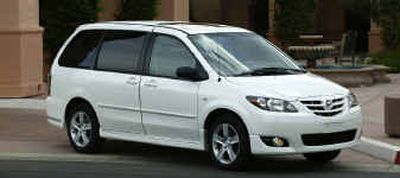MPV is now an “expressive” minivan

Spokane was beginning to feel like Phoenix North when the Mazda MPV appeared in my driveway.
Big dogs lay stunned in the shade and kids camped out under sprinklers.
Air-conditioner salespeople made hay.
If there’s such a thing as too-hot-for-a-convertible weather, this was it.
You can imagine my delight when I discovered that for 2004, Mazda has added rear-seat air conditioning to the MPV’s list of standard gear, minimizing two of the annoyances that attend minivan ownership.
First off, it’s a bear to cool the interior of a minivan — or large SUV, for that matter — when it’s truly hot out (and trust me, the opposite effect works in the winter).
Moreover, have you tried packing seven passengers into a van and finding one temperature that works for all? The folks up front freeze or those in the third row suffocate.
Other changes for ‘04 include the addition of standard four-wheel disc brakes (replacing the old front disc/rear drum setup) and ABS.
There is a facelift, too, a touch of cosmetic surgery. As they say in the trade, the MPV is now a more “expressive” minivan. I will concede that contradiction in terms, but remind you that the entire category is sexier now than 10 years ago.
Exterior updates include a new hood, headlamps, front fenders, grille, side skirts and alloy wheels. Inside, a new steering wheel is equipped with satellite audio controls,
Inside, there’s a mix-and-match mating of the sporty — embodied by the four-spoke steering wheel and chrome-plated gauge trim rings — with the classic; witness the dashboard’s sweeping curves and faux wood trim.
Four captain’s chairs comprise first- and second-row seating, while the third row bench will accommodate three in a pinch. With the bench in use, the deep floor well in which it stows, is available for cargo. Seat stowed, the cargo area gets a large, flat floor.
A spring-assist feature minimizes the muscle power required to get the seat out of its home — and the seat can be flipped to face backwards, for tailgating-type activities.
The MPV is available in two trim levels, LX ($24,010, including transportation) and
ES ($28,980).
Standard gear on all MPVs includes front and rear air conditioning, remote keyless entry, AM/FM/CD audio system, cruise control, anti-lock brakes, four captain’s chairs, tilt steering with satellite audio controls, intermittent rear wipers, and power windows, mirrors and door locks.
ES adds power driver’s seat, twin power sliding doors, floor mats, fog lamps, side-impact airbags, six-disc in-dash CD changer, rear privacy glass, leather seating surfaces, leather-wrapped steering wheel, 17-inch wheels and traction control.
The original MPV was introduced in 1988 as a 1989 model and set itself apart with optional all-wheel-drive and a single, hinged rear door in place of the more conventional slider. It was the only van whose rear windows could be rolled down.
That feature survived a model-year-2000 makeover, which added twin rear sliders and a disappearing third-row bench. Unfortunately, the all-wheel-drive option was deleted.
From the beginning, the MPV featured top-rank steering and suspension systems, and became known as a minivan with superior handling characteristics.
As vans go, it’s one of the smaller ones. Roughly the same size as Chrysler’s short-wheelbase vans, it’s about a foot shorter than the Nissan Quest, a prime competitor. Interior space is reduced, of course, but maneuverability soars. The steering system is engineered to produce a quick (3.3 turns, lock to lock) turning radius, which increases low-speed maneuverability, especially in cramped parking facilities.
When a builder of volume vehicles wants to produce a sport suspension, the solution typically is to stiffen the shock and strut settings, but Mazda engineers the answer. Front and rear sway bars, a rarity among vans, minimize body roll during turns, and the front suspension is design to create and maintain the largest “contact patch” possible between the tires and the road surface.
This attention to handling lends the MPV a reassuring margin of safety, as accident avoidance trumps seatbelts, airbags and crumple zones. Anti-lock brakes do their bit, too.
On the road, the MPV feels lively and lithe, but not insubstantial. It is well insulated against sound and the body structure is rigid and strong. Though firmly suspended, the MPV has a smooth, controlled ride.
Two years ago, the MPV received an engine transplant, with a healthy, 200-hp, 3.0-liter V6 replacing an underpowered four. A detuned version of the Mazda6 engine, it is more than adequate for daily driving — and has enough grunt to handle two-lane passing duties.
A $425 “Four Seasons” towing package includes a heavy-duty cooling system and other upgrades, boosting the towing capacity to 3,000 lbs.
The five-speed automatic transmission features “Slope Control” programming. Sensing hilly conditions, it can delay shifts to minimize unnecessary “hunting” for the correct gear.
Another nice touch: Give the engine full throttle and the tranny won’t shift until the tach hits the 6,200-rpm redline.
In a market where bigger is nearly always seen as better, the MPV may be fighting an uphill battle. However, if jumbo dimensions are not your top priority, the MPV should be on your shopping list.